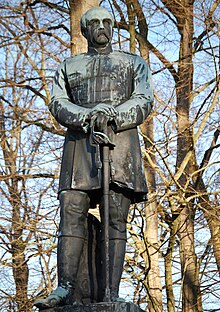
Bad Kissingen is a German spa town in the Bavarian region of Lower Franconia and seat of the district Bad Kissingen. Situated to the south of the Rhön Mountains on the Franconian Saale river, it is one of the health resorts, which became famous as a "Weltbad" in the 19th century. In 2021, the town became part of the transnational UNESCO World Heritage Site under the name "Great Spa Towns of Europe", because of its famous mineral springs and its architecture exemplifying the popularity of spa resorts in Europe during the 18th through 20th centuries.

The Rudelsburg is a ruined hill castle located on the east bank of the river Saale above Saaleck, a village in the borough of Naumburg in the county of Burgenlandkreis in Saxony-Anhalt, Germany. The Rudelsburg was built in the Middle Ages by the Bishop of Naumburg and served to secure trade routes such as the Via Regia through the Saale Valley.

Max Littmann was a German architect.

A Bismarck tower is a specific type of monument built according to a more or less standard model across Germany to honour its first chancellor, Otto von Bismarck. A total of 234 of these towers were inventoried by Kloss and Seele in 2007 but more have been discovered since making the total around 240. These towers were built between 1869 and 1934 and some 173 remain today. Quite a few of these towers, including all 47 based on Wilhelm Kreis's Götterdämmerung design, were built as so-called Bismarck Columns (Bismarcksäulen) or were converted into them. This description goes back to the Student Union's competition held in 1899, which was to encourage the erection of as many beacons as possible. But other Bismarck towers, e.g., those that were purely beacons with no observation function, were often called Bismarck columns.

Botenlauben Castle is a ruined castle in Reiterswiesen, a district of the Bavarian spa town of Bad Kissingen.

Adolf von Donndorf was a German sculptor.
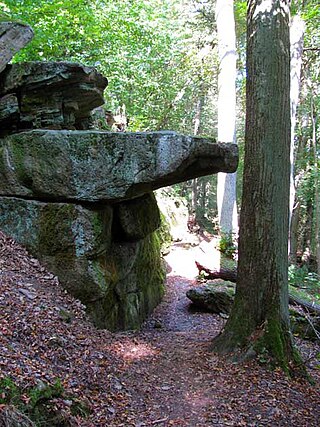
The so-called Wichtelhöhlen — goblin caves — are a rock formation with small caves located near Bad Kissingen in Lower Franconia in the center of Germany. The formation of nearly 20 sandstone rocks in the valley of the Fränkische Saale dates back to the early Triassic period.
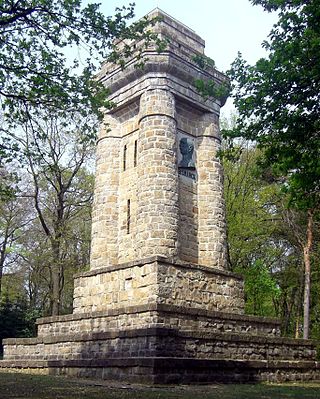
The Bismarck Tower located in Viersen was erected in honour of the chancellor Otto von Bismarck and has since become an icon of the city of Viersen.
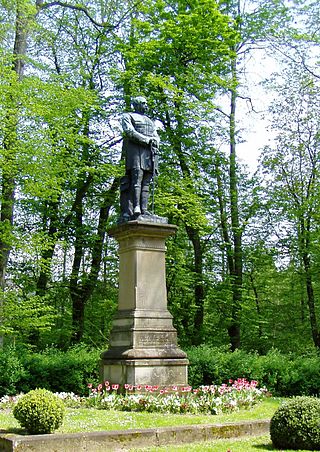
From 1868 onwards, Bismarck monuments were erected in many parts of the German Empire in honour of the long-serving Prussian minister-president and first German Reichskanzler, Prince Otto von Bismarck. Today some of these monuments are on the soil of other countries including France, Poland and Russia as well as the former German colonies on other continents.
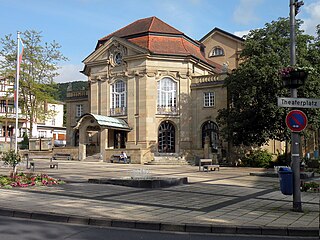
The Kurtheater Bad Kissingen is a theatre in the spa town Bad Kissingen in Bavaria, Germany.
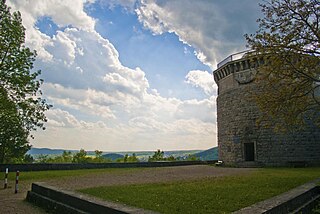
The construction of the Bismarck Tower located on the "Sinnberg", a hill in the German spa town of Bad Kissingen, started in 1914 following the plans designed by architect, Wilhelm Kreis. It was projected by the local Bismarck Tower Association under the chairmanship of its founder, pharmacist Oscar Ihl. This association was in favour of Bismarck and the German Empire and competed in a certain way with the Wittelsbacher Association, which, even after the Unification of Germany, regarded the Kingdom of Bavaria to be a sovereign kingdom and built the Wittelsbacher Tower in Bad Kissingen in 1907.

The Wittelsbacher Jubiläumsturm is a look-out at the "Scheinberg", a hill which is 400 metres high and located in Arnshausen, a quarter of the German spa town of Bad Kissingen. The tower belongs to the heritage registers of Bad Kissingen and has an entry in the List of Heritage Registers in Bavaria.

Reichshund was an informal term used in Germany for Reichskanzler Otto von Bismarck's dogs and more generally for similar dogs, particularly Great Danes.

The Siegesdenkmal in Freiburg im Breisgau is a monument to the German victory in the Franco-Prussian War in 1871. It was erected at the northern edge of the historic center of Freiburg im Breisgau next to the former Karlskaserne (barracks). After World War II it was moved 100m to the west. Today it is located on Europaplatz.

The Regentenbau is a German concert hall in the town Bad Kissingen in Bavaria.

The Battle of Kissingen was a battle between Bavarian and Prussian troops on 10 July 1866 during the Austrian-Prussian War in and around the town of Kissingen in Bavaria. It was part of the campaign of the Main and ended with a victory of the Prussians.

The Bismarck tower in Freiburg im Breisgau belongs to a series of towers that were built in honor of Otto von Bismarck, the first German chancellor. It is located on the Schlossberg. It is 12.6 m (41 ft) tall and has a square base. The top of the tower can only be reached by climbing a ladder. Because of this it can not be used as an observation deck.

Hans Dammann was a German sculptor; known primarily for his war memorials.
Heinrich Andreas Contius, also Cuntius is considered the most important organ builder in the Baltic States in the 18th century.
Julius Bayerle was a German sculptor and painter as well as a teacher at the Kunstakademie Düsseldorf.
